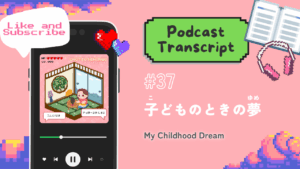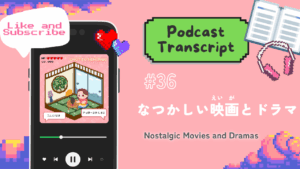おすすめの Google 拡張機能です!新しい言葉を勉強しましょう!
Here are the recommended Chrome extensions! Let’s learn new words here!
ポッドキャストプラットフォーム|Platforms of Podcast
こちらの記事は、配信中のポッドキャストのスクリプトです。
ぜひ、ポッドキャストを聞きながら読んでください。
 えみ先生
えみ先生もう聞いた人は、クイズをチェックしましょう!
ちょっとクイズ!|CHOTTO Quiz!
ポッドキャストを聞いた人は、ちょっとクイズを解いてみましょう。
むずかしいときは、下のスクリプトを読んで、もう一度クイズをチェックしてみてください。
【えいご】English Translation
Answer these quiz questions if you’ve listened to a new episode of my podcast.
If it was difficult, read the transcript below and try again.
❓ 新幹線には、どんなタイプの席がありますか?|What types of seats do they have in the Shinkansen?
場所が決まっている「指定席」と、どこでも座れる「自由席」があります。🚄
There are Shitei-seki (Reserved seat) and Jiyuu-seki (Non-reserved seat.)
❓ 一番、たくさん駅に停まる電車はなんですか?? | What’s the train that stops every stations?
「各駅停車」です。ほとんど、ぜんぶの駅に停まります。
It’s “Kakueki Teisya (Local train.)” This train stops every stations.
❓ 日本の電車で、食べたり飲んだりしてもいいですか? | Is it okay to eat or drink on regular Japanese trains?
いいえ、電車では食べたり飲んだりしてはいけません。
でも、新幹線は食べたり飲んだりしてもいいです。🚄🍱
No, you cannot eat or drink on regular trains in Japan but you can in Shinkansen.🚄 🍱
ポッドキャストのスクリプト|Transcript of Podcast
エピソード18、「電車のルール」
このポッドキャストは、初中級(Pre-Intermediate)レベルです。
おはようございます。こんにちは。こんばんは。
日本語の先生、エミです。
今週は、私の誕生日がありました。
私の誕生日は 4月9日なんですが、30歳になりました。
20代から30代になりました。
大きな変化ですね。
30代も、毎日私らしく楽しもうと思います。
よろしくお願いします。
【えいご】English Translation
Good morning. Hello. Good afternoon.
I am a Japanese teacher, Emi.
This week, it was my birthday.
My birthday is April 9th, and I turned 30.
I went from my 20s to my 30s.
That’s a big change.
I want to enjoy my 30s being myself every day.
Thanks for your continued support!
ここで先週の質問をチェックしましょう。
先週は こんな質問をしました。
「旅行のとき、どんな乗り物に乗りますか?
どれが一番好きですか?」
こんな質問でした。
たとえば、飛行機、バス、車、そして電車。
いろいろありますね。
今日のテーマは「電車のルール」です。
日本にはたくさんの電車があります。
ルールもいろいろあります。
今日は、日本で電車に乗るときに 知っておくといいことを話します。
【えいご】English Translation
Alright, now let’s check last week’s question.
Last week, I asked this question:
“When you travel to Japan, what kind of place do you stay at?“
That was the question.
For example, airplane, bus, car, and train.
There are many kinds, right?
Today’s theme is “Train Rules”.
There are many trains in Japan.
And many rules, too.
Today, I’ll talk about things that are good to know when riding trains in Japan.
まず、新幹線です。
新幹線は、とても早い電車です。
東京から大阪まで、2時間30分ぐらいで行けます。
日本に旅行に来たら、みなさん新幹線に乗りますね。
新幹線には2種類の席があります。
指定席と自由席です。
【えいご】English Translation
First, the Shinkansen.
The Shinkansen is a very fast train.
You can get from Tokyo to Osaka in about 2 hours and 30 minutes.
I know everyone rides the Shinkansen when traveling in Japan.
There are two types of seats on the shinkansen:
Shitei-seki (reserved seats) and Jiyuu-seki (non-reserved seats.)
指定席はチケットに席の番号が書かれてあります。
その番号が自分の席です。ほかの席に座ってはいけません。
自由席は席が自由です。
好きな席に座ってもいいです。
でも、混んでいるときは座れないこともあります。
【えいご】English Translation
Shitei-seki (Reserved seats) have a seat number written on the ticket.
That number is your seat. You must not sit in a different seat.
Jiyuu-seki (Non-reserved seats) are open seats.
You can sit in any seat you like.
But when it’s crowded, you may not be able to sit.
旅行のときは指定席が便利です。
でも、少し高いです。
私は、先週新幹線で名古屋に行きましたけど、自由席のチケットを買いました。
でも、お正月とか ゴールデンウィークは指定席を予約するのがおすすめです。
【えいご】English Translation
For travel, reserved seats are convenient.
But they’re a bit more expensive.
Last week, I went to Nagoya on the Shinkansen and bought a non-reserved seat ticket.
But for New Year’s or Golden Week holidays, I recommend reserving a seat.
日本には新幹線だけじゃなくて、普通の電車もたくさんあります。
そして、電車にはいろいろなスピードの電車があります。
電車のスピードは同じなんですけど、停まる駅の数が違います。
【えいご】English Translation
In Japan, there are not only shinkansen but also many regular trains.
And there are different train speeds.
The speed is the same, but the number of stops is different.
たとえば、各駅停車。
各駅停車は、全部の駅に停まります。
一番遅いです。
たとえば、東京の山手線。
Yamanote Lineは、全部の駅に停まりますね。
【えいご】English Translation
For example, “Kakueki-Teisha (local train.)”
It stops at every station.
It’s the slowest.
For example, the Yamanote Line in Tokyo.
The Yamanote Line stops at every station.
そして、次は準急。
少し停まる駅が少なくなります。
そして、急行。
急行はもっと早くなります。停まる駅は少ないです。
【えいご】English Translation
Next is “Jun-Kyuu (semi-express)”.
It skips a few stations.
Then, the “Kyuukoo (express)”.
It’s faster and stops at fewer stations.
そして、快速急行。
これはとっても早いです。
駅にあまり停まりません。
でも、大きな駅にだけ停まりますから、たとえば、東京駅に行きたいときとか、新宿駅に行きたいときは、快速急行 たくさんあると思います。
【えいご】English Translation
Then, the “Kaisoku-Kyuukoo (rapid express)”.
This is very fast.
It doesn’t stop at many stations.
But it stops at big stations, so if you want to go to Tokyo Station or Shinjuku Station,
I think there are many rapid express trains.
でも、小さい駅に停まりたいです。というときは、快速急行に乗ると行くことができません。
だから、どのスピードの電車に乗るか、よくチェックしましょう。
停まる駅は、電車によって違います。
乗る前に、駅のアナウンスやモニターを確認しましょう。
【えいご】English Translation
But if you want to stop at a small station, you can’t go there by Kaisoku-Kyuukoo (rapid express).
So, check carefully which speed train you ride.
The stations they stop at are different depending on the train.
Before you ride, check the station announcement or the monitor.
はい。
日本の電車には、いろいろなルールがあります。
みなさんは、どんなルールを知っていますか?
たとえば、日本の電車は電話で話すことができません。
でも、メールやメッセージはOKです。
【えいご】English Translation
Yes.
There are many rules on Japanese trains.
What rules do you know?
For example, in Japanese trains, you can’t talk on the phone.
But texting or messaging is OK.
あと、大きな声で話してはいけません。
静かにしましょう。
友達と電車に乗っているときも、大きな声じゃなくて、小さな声とか、普通の声で話しましょう。
【えいご】English Translation
Also, you must not talk in a loud voice.
Please be quiet.
Even when riding with friends, talk in a small voice or normal voice, not a loud one.
あと、日本の電車も優先席があります。
Priority Seatです。優先席。
お年寄りや妊娠している人、けがをしている人のために、ゆずりましょう。
【えいご】English Translation
Also, Japanese trains have priority seats.
They are for the elderly, pregnant women, or people who are injured.
Let’s give up our seats for them.
そして、最後のよくあるルールは、電車の中で 食べたり飲んだりすることができません。
でも、新幹線の中では食べても大丈夫です。
でも、普通の電車はみんな食べたり飲んだりしませんね。
【えいご】English Translation
And the last common rule is:
you cannot eat or drink on regular trains.
But on the Shinkansen, eating is OK.
On regular trains, people usually don’t eat or drink.
はい。
いろいろなルールがあります
けど、電車に乗ったら周りの日本人を見てみてください。
たぶん新しいルールが見つけられると思います。
【えいご】English Translation
Yes.
There are many different rules,
But when you ride the train, look at the Japanese people around you.
You’ll probably discover some new rules.
では、今日も みなさんに 質問があります。
「みなさんの 1日のルーティーンはなんですか?
朝起きてから夜寝るまでいつもどんなことをしますか?」
みなさん、朝何時に起きますか?
そして何時に寝ますか?
何時に学校や仕事に行きますか?
来週は、私の仕事の日のルーティンを話したいと思います。
【えいご】English Translation
Now, I have a question for you today as always.
“What’s your daily routine?
What do you usually do from the time you wake up in the morning until you go to bed at night?”
What time do you wake up in the morning?
And what time do you go to bed?
What time do you go to school or work?
Next week, I want to talk about my workday routine.
今日のポッドキャストのスクリプトは、私のウェブサイトにあります。
ウェブサイトは、 en-nihongo.com です。
よかったら、ポッドキャストの感想や、質問の答えをコメントで教えてください!
じゃあ、また来週のポッドキャストで会いましょう。
じゃあね~!
【えいご】English Translation
A transcript for today’s podcast is on my website.
The website is en-nihongo.com .
I’d be very happy if you could share your thoughts/impressions or could answer the question I asked in this episode!
I’ll see you in the next episode.
Jaa ne-!







コメント|Comment